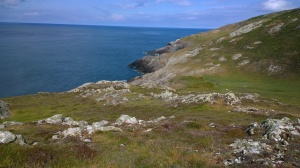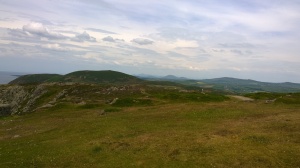Aberdaron is the nearest place to Mynydd Mawr and I stop here for provisions before going further. I soon discover there is no bank or ‘hole-in-the-wall’. A Spar is the only shop selling food and the choice is limited. I kick myself for not going into Abersoch before coming here as I don’t have much cash on me; the campsites around here are on farmer’s fields and I’m unlikely to be able to pay with a card.
Luckily, the shop is taking card payments so I ask for cash-back. How much, the lady at the till asks? I make a tentative bid for fifty.
“Ooh, fifty?” she says, sucking the air between her teeth, “I don’t know…”
Looks are exchanged between her and the person behind the post office grill at the back of the shop while I hold my breath. There is a nod of assent and she says ‘yes, it will be alright’. Phew!
I go in search of Mynydd Mawr which is about three miles away along twisting, narrow lanes. I am in time to reunite the lovely, Scottish lady with her walking stick before they head off home.
On our first morning I awake to the sight of a flock of crows flying overhead, though they make a noise like no crows I have heard before. I discover they are choughs; the red-beaked, red-legged variety of crow that lives in this part of the world.
The landscape here is not far from the chin of the Llyn and yet it is so different. Here, there are no beaches; mountains drop steeply down into the ocean from dizzying heights.
From the topmost part of Mynydd Mawr, the views extend away up the northern edge of the Llyn. Up here there is an old coast-guard’s hut where a map on the wall shows the shocking number of shipwrecks which have occurred around the LLyn over the past few hundred years. It is said that a local family still possess a barrel of whisky which was washed up from a shipwreck in 1908.
Near the top of the cliffs, there is a massive standing stone, pointing out towards Bardsey Island to show the ancient pilgrims which way to cross the treacherous waters….
The nearest sandy cove seems to be Whistling Sands, a few miles up the coast, famous for the sand which makes whistling, squeaking noises beneath your feet.
I’ve heard about them many times, which is probably why my experience of them fell short of my expectations. For me, it was the cove at the end of the sands which was most rewarding. The massive slabs of rock here were shot through with a myriad of patterns in rich blues, greens, purples and golds. They are stunningly beautiful. Someone tells me there is a jasper mine not far from here, the stone from which went into the Liver building…
I had planned to stay at Mynydd Mawr for a couple of nights but ended up staying three. I was reluctant to leave it behind but found there was something about that landscape which made me feel lonesome for company; a loneliness exacerbated by an absence of wi-fi and mobile phone signal. Some places are better shared with other people, I guess.
So it was, on the fateful Sunday morning which was to bring the freak accident and an end to my travels, I headed off in search of a place called Porth Iago. I wanted to go and see this place for two reasons; I had been told it was a stunningly beautiful cove, and Iago was the Welsh name of the anti-hero in my novel, Leap the Wild Water, who ruined poor Megan. How could I resist going in search of a place of the same name? (Iago, by the way, is the Welsh version of James.)
Needless to say, I never saw a signpost for Porth Iago and had gone some way up the coast line before I realised I had gone much too far and pulled into the car-park for Penllech beach to consult my map-book. The rest, as they say, is now history.
Jenny Lloyd is the Welsh author of The Megan Jones trilogy, historical suspense novels set in early, 19th century, rural Wales.



You can read about the books and purchase them by clicking on the links below.
Leap the Wild Water: http://ow.ly/jEoi302jXkd
The Calling of the Raven: http://ow.ly/4uRO302jXmd
Anywhere the Wind Blows: http://ow.ly/i1sy302jXXK
Follow me:
Twitter; https://twitter.com/jennyoldhouse
Facebook; https://www.facebook.com/jennylloydauthor
Pinterest; http://www.pinterest.com/jennyoldhouse










I know nothing of this Coast Jenny (I’m more an east coast man) but you make it so appealing – apart from the tonnage of wackos you encounter! But there’s something about the edge of land that does that to some people – too much sun and salt perhaps. Glad I found your blog. Really enjoyable
Haha! Yes, I seem to attract an alarming number of wackos! I’m so glad you’re enjoying the adventure with me.
Definitely a book in the making, Jenny. My grandad left a walking stick in a Welsh loo in about 1980…if you come across it ;-D
I meet enough strange people as it is, without frequenting men’s loos!
Thoroughly agree that you have a book in the making. Obsessing over your beautiful photographs. Am now a devotee of all things Welsh. I have dreamed of places like this all my life – lovely, lovely British Isles – my favourite countries and landscapes in the world! Treasured books: “Some Lovely Islands” by Leslie Thomas and “Wynford Vaughan-Thomas’s Wales”. Hauled out the later so I can see on the map exactly where you are.
Amazing vistas! I so want to return to Wales.
Then you must, as soon as you possibly can. Maybe our paths will cross!
I agree with the others about a book. I think it’s a must! A travelogue for sure. It reminds me in some ways of Trish Nicholson’s Journey to Bhutan (which I loved). Wales is somehow just as wild and stunning and I love your encounters. The way you describe the people you meet is wonderful – funny, witty and so well observed. And of course your photos are stunning! I’ve read both these last two posts in one (I don’t know why I don’t get the notifications) and loved them!
Thank you for your lovely comments, Val.
What a wild and wondrous coast you wander! Those colorful rocks are beautiful. My husband grew up in northern Nevada near what is called Sand Mountain. It is a mountain of sand and we’ve hiked it in moonlight and run down it with the sands singing beneath our feet. I’m told it is quartz that creates whistling or singing sand.
I wonder how many more places there are with whistling sand! Perhaps it is more common than I supposed.
I don’t think it is real common. In the US singing sand is found in NV or around the Great Lakes.